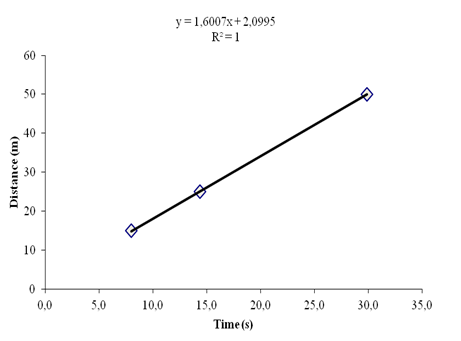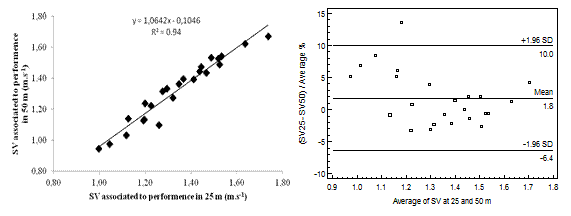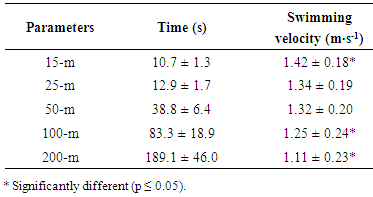-
Paper Information
- Next Paper
- Previous Paper
- Paper Submission
-
Journal Information
- About This Journal
- Editorial Board
- Current Issue
- Archive
- Author Guidelines
- Contact Us
International Journal of Sports Science
p-ISSN: 2169-8759 e-ISSN: 2169-8791
2016; 6(1A): 31-35
doi:10.5923/s.sports.201601.06

Anaerobic Critical Velocity and Sprint Swimming Performance in Master Swimmers
Mario André da Cunha Espada1, 2, Aldo Costa3, 4, 5, Hugo Louro5, 6, Ana Conceição5, 6, Dalton Muller Pessôa Filho7, Ana Pereira1, 4
1Polytechnic Institute of Setubal, School of Education, Setubal, Portugal
2Interdisciplinary Centre for the Study of Human Performance, Lisbon, Portugal
3Department of Sports Science, University of Beira Interior, Covilhã, Portugal
4Health Sciences Research Center (CICS-UBI), Covilhã, Portugal
5Research Centre for Sport, Health and Human Development (CIDESD), Vila Real, Portugal
6Sport Sciences School of Rio Maior, Polytechnic Institute of Santarém, Rio Maior, Portugal
7São Paulo State University - UNESP, Bauru, Brazil
Correspondence to: Mario André da Cunha Espada, Polytechnic Institute of Setubal, School of Education, Setubal, Portugal.
| Email: |  |
Copyright © 2016 Scientific & Academic Publishing. All Rights Reserved.
This work is licensed under the Creative Commons Attribution International License (CC BY).
http://creativecommons.org/licenses/by/4.0/

The aims of this study were to determine and analyze the relationship between anaerobic critical velocity (AnCV, m.s-1) in master swimmers and short swimming distances performances. AnCV was determined for twenty four male master swimmers (42.0 ± 7.5 years) based on the performance in 15, 25, and 50 m swimming distances. Data was calculated for each swimmer using the slope of the distance-time relationship and compared with the individual best swimming performance in 100 and 200 m distances. AnCV15-25 (1.25 ± 0.22 m.s-1) was significantly lower than AnCV15-25-50 (1.29 ± 0.23 m.s-1) and AnCV25-50 (1.31 ± 0.23 m.s-1) was significantly faster compared to AnCV15-25 and AnCV15-25-50. All AnCV combinations were strongly correlated with swimming performance in 25, 50 and 100 m front-crawl (above 0.90, p < 0.01), and 25 and 200 m performances in master swimmers (below 0.90, p < 0.01). These findings suggest that AnCV can be used as a race-pace training reference to monitoring and prescribing anaerobic training in master swimmers, a non-invasive and inexpensive method that can estimate parameters normally obtained from blood lactate analysis.
Keywords: Master swimmers, Distance-Time relationship, Anaerobic critical velocity, Swimming performance
Cite this paper: Mario André da Cunha Espada, Aldo Costa, Hugo Louro, Ana Conceição, Dalton Muller Pessôa Filho, Ana Pereira, Anaerobic Critical Velocity and Sprint Swimming Performance in Master Swimmers, International Journal of Sports Science, Vol. 6 No. 1A, 2016, pp. 31-35. doi: 10.5923/s.sports.201601.06.
Article Outline
1. Introduction
- The maintenance of involvement in sports with advancing age is associated with social and physical benefits, reasons associated with the increased number of regular practitioners. However, advancing age is associated to a decline in physiological functional capacity, resulting in reduced performance in various tasks and a concomitant increase in morbidity and mortality [1, 2]. Despite this fact, master competitions are no longer an extension of recreational sports as in the past. Instead, are a combination of fitness-oriented people and a lot of performance driven individuals looking for self-improvements each time they compete [3].Swimming is a relatively low-impact, low-resistance sport, particularly suitable for the elderly [4], it is a growing movement worldwide and the 50 m event is nowadays the most participated event in official competitions. This swimming distance is aside of the 100 and 200m, the ones who present more anaerobic contribution. Even thou, according to Rubin and Rahe [5], the age-related decline in performance among swimming national champions, both men and women and in short and long swimming events, is linear, at approximately 0.6% per year up to age 70-75.Long time ago, Monod and Scherrer [6] observed a hyperbolic relationship between the level of constant power output (P) and corresponding time to exhaustion (t) in a single muscle group. This relationship can be expressed in a linear form from total work performed (W) and “t”, given the product Pt. The intercept of this line was termed the ‘‘anaerobic work capacity’’ (AWC) and its slope termed the ‘‘critical power’’ (CP) defined as the work capacity that can be keep up for a very long time without fatigue, expressed by the following equation:
 | (1) |
 | (2) |
2. Methods and Procedures
2.1. Subjects
- Twenty four male master swimmers (42.0 ± 7.5 years, 1.74 ± 0.10 m, 74.8 ± 14.1 kg and 24.7 ± 3.5 kg∙m2) participated in this study. Volunteered subjects participated in a regular basis in regional and national level competitions and signed a consent form in which the present protocol was explained. All procedures were in accordance to the Declaration of Helsinki in respect to Human research. The Ethics Committee of the hosting Higher Education Institution approved the study design.
2.2. Procedures
- Time performance for 100-m and 200-m races was obtained during front-crawl started from dive. AnCV was determined through three short-distance swimming performance in front-crawl swimming (15, 25 and 50-m) with in-water start for the elimination of the dive influence. A standard warm-up was performed before teach trial (600 m and 10 min rest). The tests were performed in a 25-m indoor swimming pool, with 28ºC water temperature and less than 75% of humidity). Performance was determined by two expert researchers with a chronometer (Seiko S140, Japan), and the mean value assumed (never above 0.20 seconds). Each individual swimming bout was separated by a 10-minute rest interval.AnCV was calculated for each swimmer using the slope of the distance-time (Dd-t) relationship, plotting the following swimming time performance over time: 15, 25 and 50- m. The equation of the regression line obtained was of y = ax + b type, where here y is distance swam, x is time and a = Anaerobic critical velocity (i.e., strait-line slope), b is y-interception value [20, 22]. The coefficient of determination (R2) was calculated to determine the strength of the regression line equation.
2.3. Statistical Treatment
- The normality and homoscedasticity assumptions of all distributions were verified using a Shapiro-Wilk and Levene tests. Standard descriptive statistical methods were used for the calculation of means and standard deviations. The Pearson product moment correlation coefficient (r) was used to verify the associations between AnCV and swimming performance. In order to compare mean values of each swimming velocity (SV), a repeated–measures analysis of variance with Bonferroni adjustment was used. Statistical significance for all analyses was as accepted at p ≤ 0.05.
3. Results
- Mean swimming performance and the respective SV in the covered swimming distances are present in Table 1 and an example for AnCV modelling approach is showed in Figure 1. Both SV25 on SV50 were strongly associated (R2 = 0.94; SEE = 0.05, Figure 2). Figure 2 also show Bland-Altman plot with the bias and limits of agreement between SV25 on SV50 evidenced that the random scatter of points between the upper and lower confidence limits is indicative of relatively a good fit, although, the range between these two limits is too broad.
|
 | Figure 1. An example of the assessment of anaerobic critical velocity for one swimmer (AnCV15,25,50 = 1.60 m∙s-1) |
 | Figure 2. Linear regression of SV25 on SV50 (SSE = 0.04 m∙s-1) and Bland-Altman plot showing the agreement between SV25 and SV50 |
|
 | Figure 3. Linear regression between AnCV from combining swimming distances and velocity performance during 100 a 200-m |
4. Discussion
- The aims of the present study were to determine AnCV in master swimmers and to comparing it with short swimming distances performances. To our best knowledge, the present study is the first to analyse the relevance of this functional parameter of training control in master swimmers. The results showed that both AnCV15,25, AnCV25-50 and AnCV15-25-50 combinations were strongly correlated with swimming performance in 25, 50 and 100 meters front-crawl (above 0.90, p < 0.01), and 25 and 200 m performances in master swimmers (below 0.90, p < 0.01). The lack of previous studies in master swimmers makes it difficult to compare our data. Nevertheless the results seem to be in accordance with previous studies conducted by other authors [20-23], predominantly in young swimmers.For example, it was previously reported a high linearity between distance covered and the corresponding time in the individual AnCV assessment [21-24]. Our results also support these findings, which mean that it is possible to assess AnCV through working with linear relationships within specific short swimming distances tests and the corresponding times. Even, we would like to highlight the strong correlation coefficient between AnCV and T50, the most popular swimming event in master competitions, which is in strong agreement with the data reported by Marinho et al. [22] for age-group swimmers. Our correlation coefficient values were slight higher than those presented by the existing literature, which may be explained by differences in age and experience. The T15 should only reflect breakdown of PCr (ATP-PCr shuttle), not anaerobic glycolysis since the time to cover the 15 m swimming distance is too brief to exploit the glycolytic ATP production system completely. This fact resulted in lower correlations values when compared to 25 and 50 meters swimming distances.Other works found correlations between the AnCV and maximal performance for 100-m [24] and 200-m [22] races. Louro et al. [24] reported values of r = 0.88 (p < 0.01), as well as, no significant differences between swimming velocity at AnCV and 100-m freestyle in adult swimmers (1.61 ± 0.07 m∙s-1 and 1.60 ± 0.08 m∙s-1). Convergent results were found by several authors regarding AnCV and the performance during 50-m. Abe et al. [20] reported a strong association between the AnCV and the 50-m breaststroke performance (r = 0.85, p ≤ 0.05). Neiva et al. [23] obtained values of r = 0.81 (p ≤ 0.01) for backstroke, r = 0.83 (p ≤ 0.05) for breaststroke, and r = 0.78 (p ≤ 0.01) for front-crawl. Fernandes et al. [21] also indicated values of r = 0.84 (p < 0.01) for front-crawl performance. Complementarily, the present study added that the coefficient of correlation between the AnCV and swimming performance decrease as the distance increases (between 100-m and 200-m). This is an expected result, justified by the fact that the preponderance of the anaerobic metabolism in maximal efforts decrease over time. Therefore, the performance while swimming distances over 200-m has an increasing influence of aerobic metabolism [25-27].Also, CV was correlated to AnCV, highlighting the pertinence of this parameter not only to anaerobic training, but also aerobic/anaerobic demanding races, as the 100-m and 200-m. The anaerobic metabolism has a significant role to overall energy [25, 27, 28]) and a substantial contribution for the 50-m swimming races, approaching 80% or more of total energy demand [29]. This fact supports the notion that the 50-m should be involved in AnCV determination, but should not be used for the estimation of CV. For that reason, higher linear relationships were obtained between the combination AnCV25-50 and AnCV15-25-50 and 100-m swimming performance. Otherwise, even during a single 30-s swimming bout, the aerobic energy contribution approaches almost 33% [29], which is similar to that previously reported using a swimming flume [27]. Louro et al. [24] also found that adult swimmers were not able to sustain the velocity at AnCV longer than 97.22 ± 20.51 meters. However, no relationship was found in Louro et al [24] study between the total distance swam and AnCV (r = 0.27, p = 0.49), which probably means that a high anaerobic performance is not directly associated to better swimming performances for distances higher than 100-m [30].
5. Conclusions
- The results suggest that AnCV can be an important indicator of performance for the 100-m swimming races, and could be used as training parameter for short-distances events (25-m and 50-m). As such, coaches can use AnCV as a race-pace training reference to monitoring and prescribing anaerobic training in master swimmers, thus be applied as a non-invasive an inexpensive method that can estimate parameters normally obtained from blood lactate analysis. This concept might be relevant to the maximal swimming velocity, as an inexpensive and non-invasive method it seems relevant to conduct further studies to validate the use of this recent functional parameters of the swimmer’s anaerobic fitness. Further studies should be conducted involving different swimming techniques and distances, kinematic parameters and gender differences.
 Abstract
Abstract Reference
Reference Full-Text PDF
Full-Text PDF Full-text HTML
Full-text HTML
